
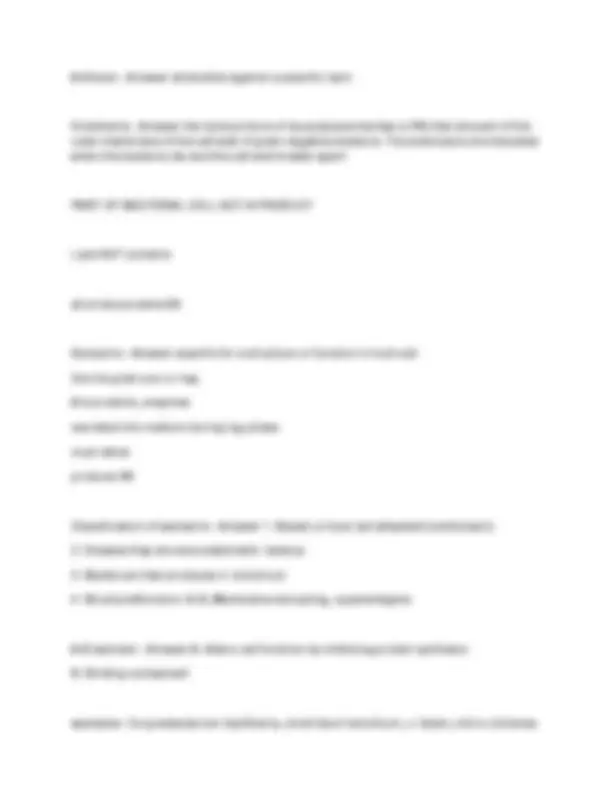
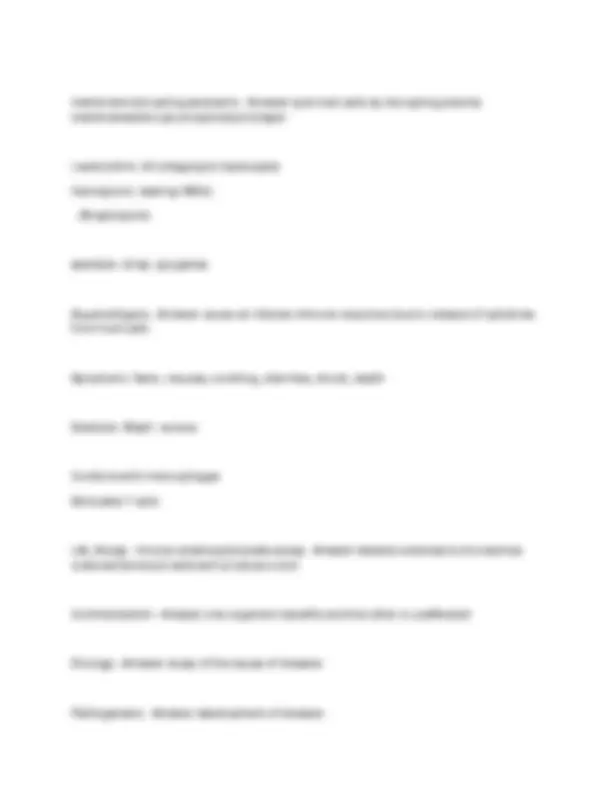
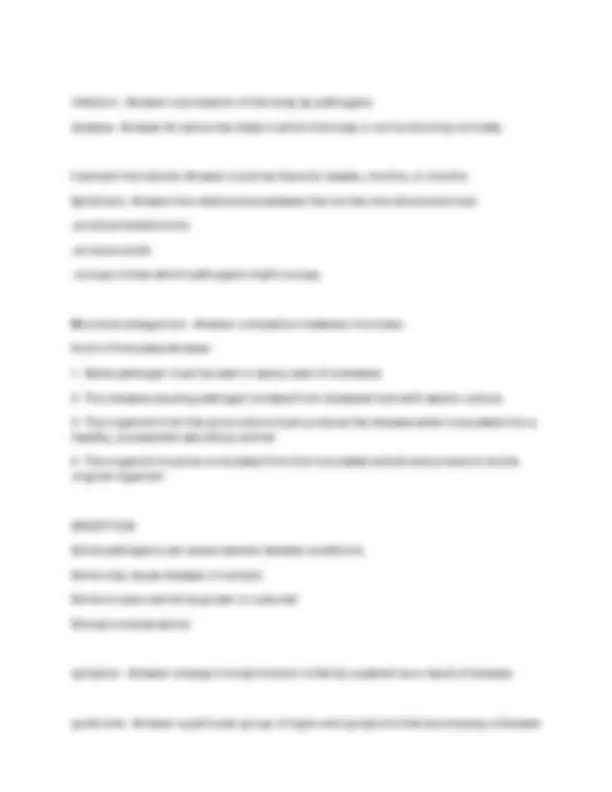
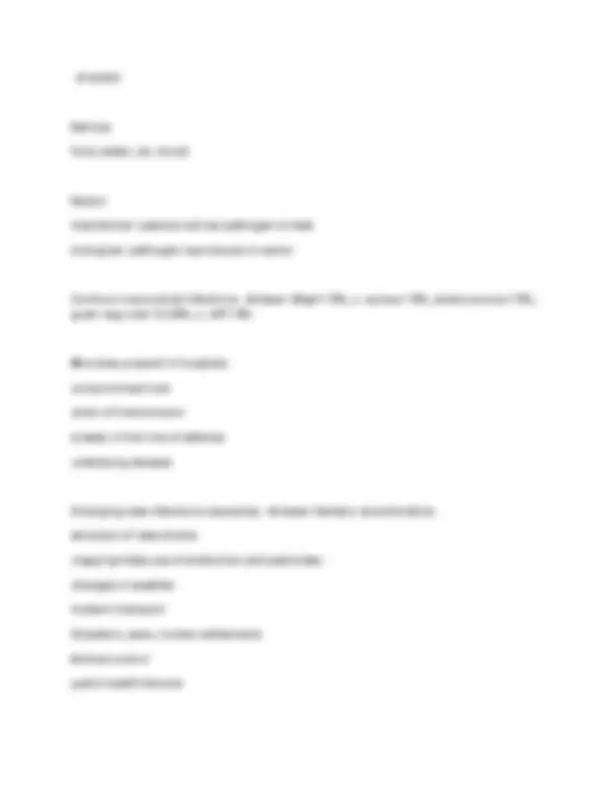
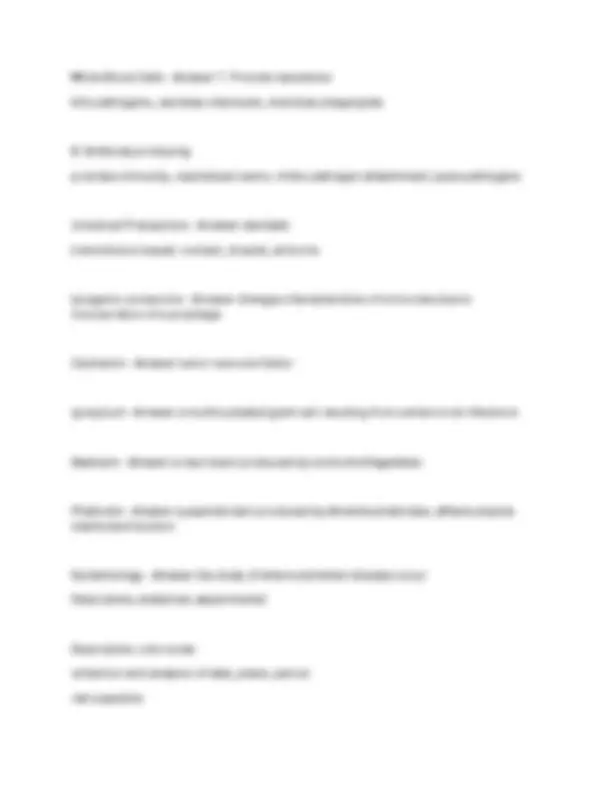

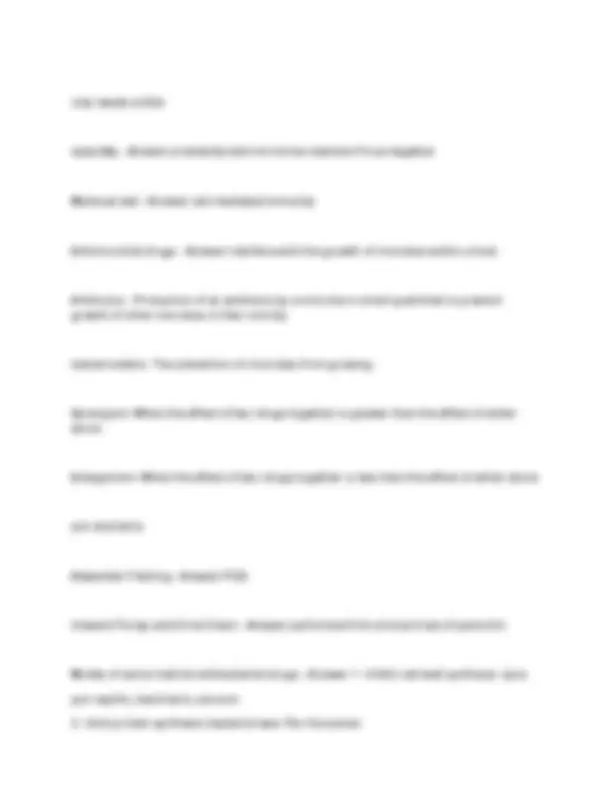
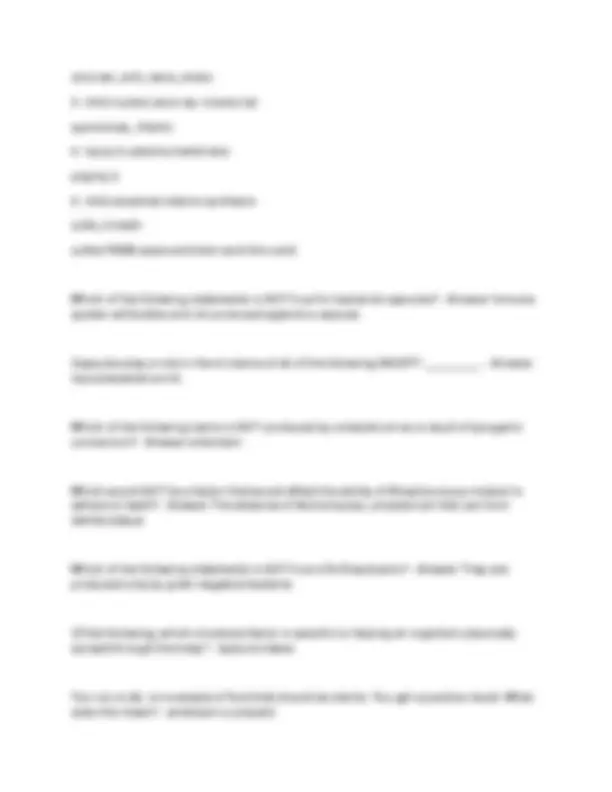
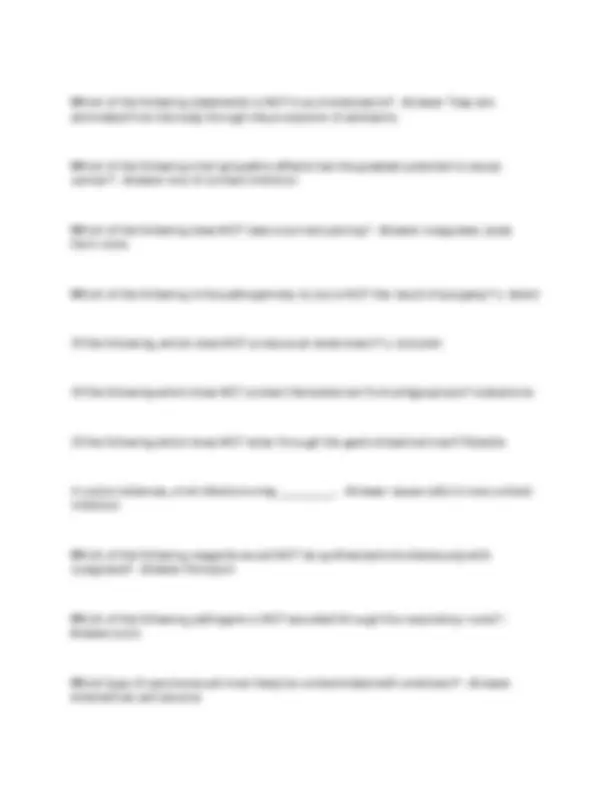
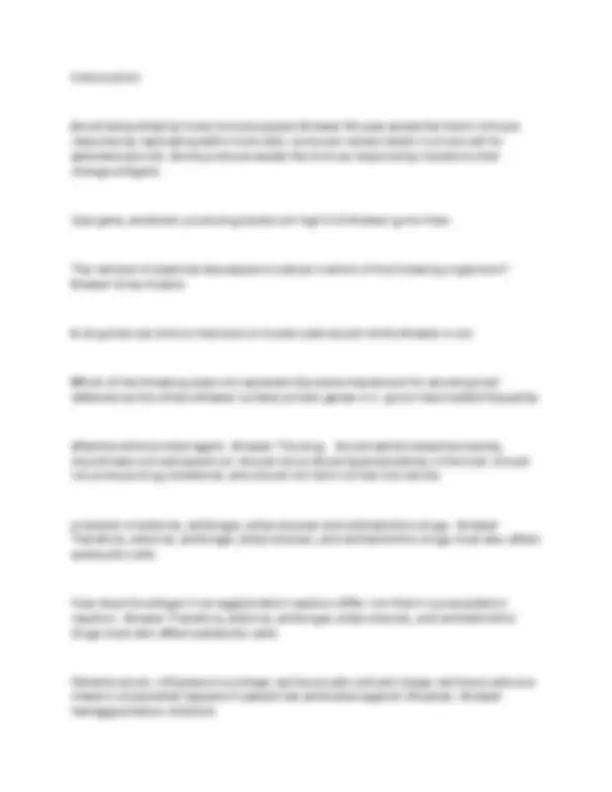
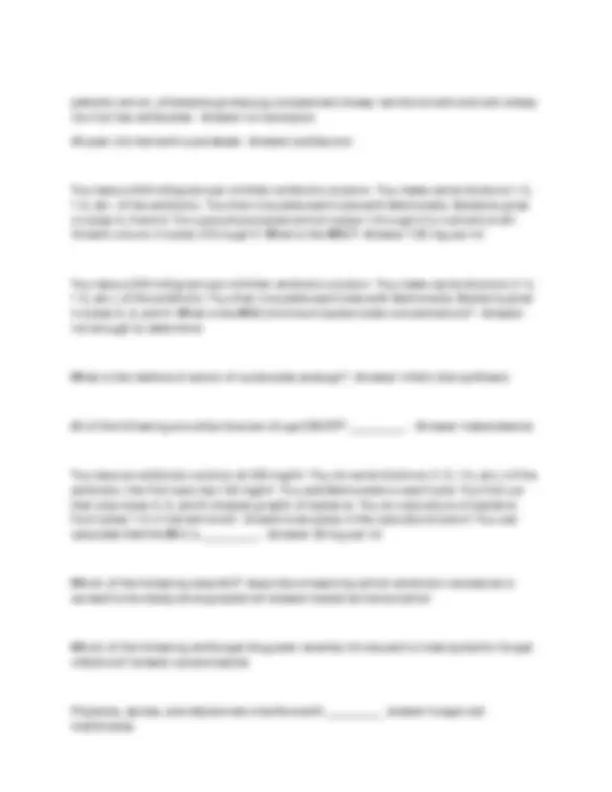
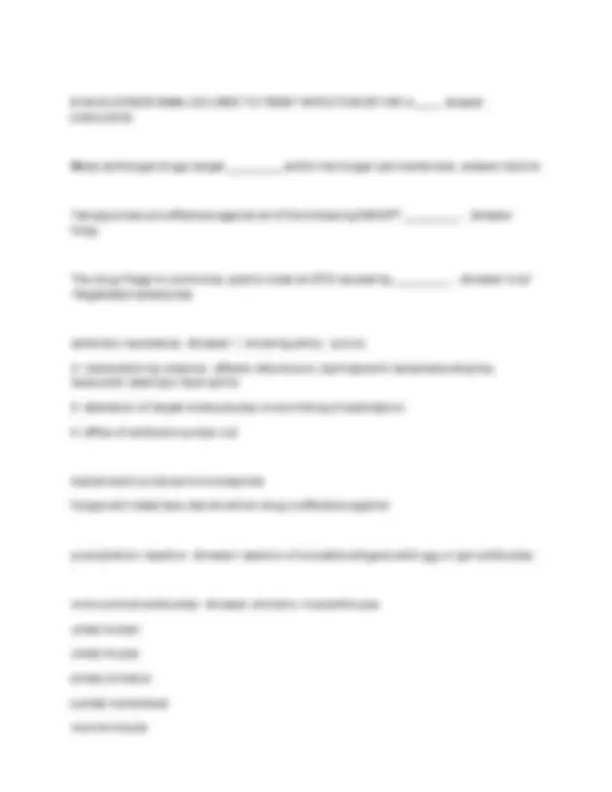
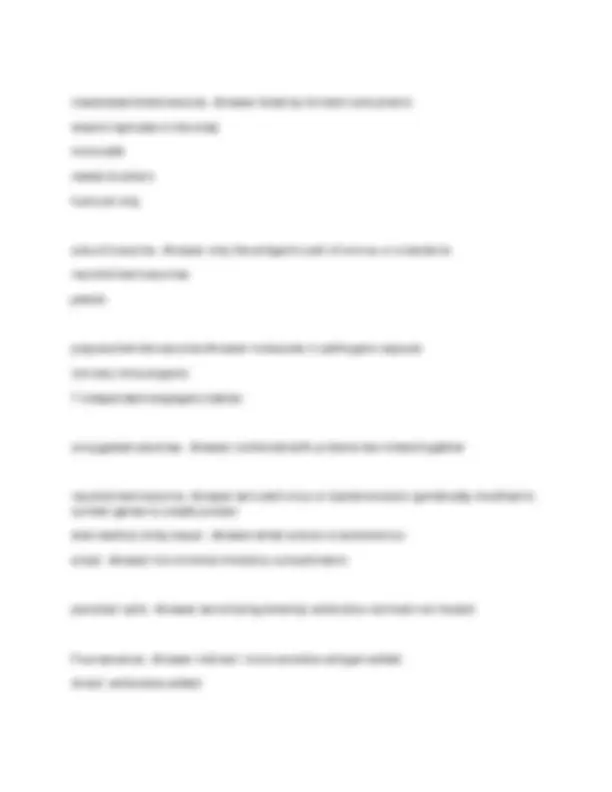
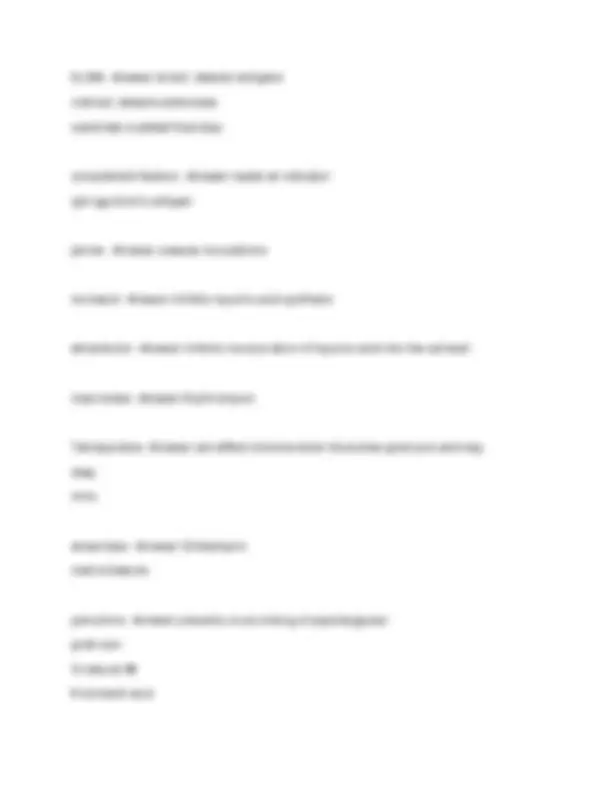
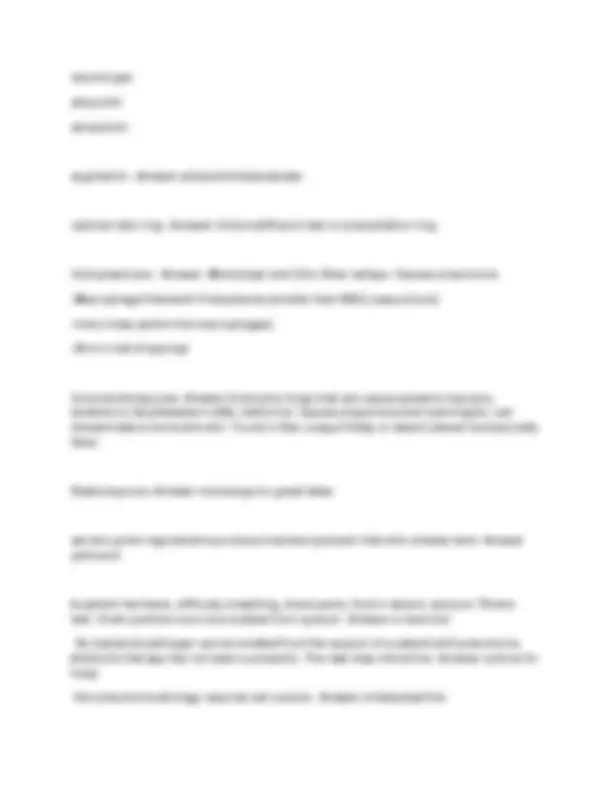
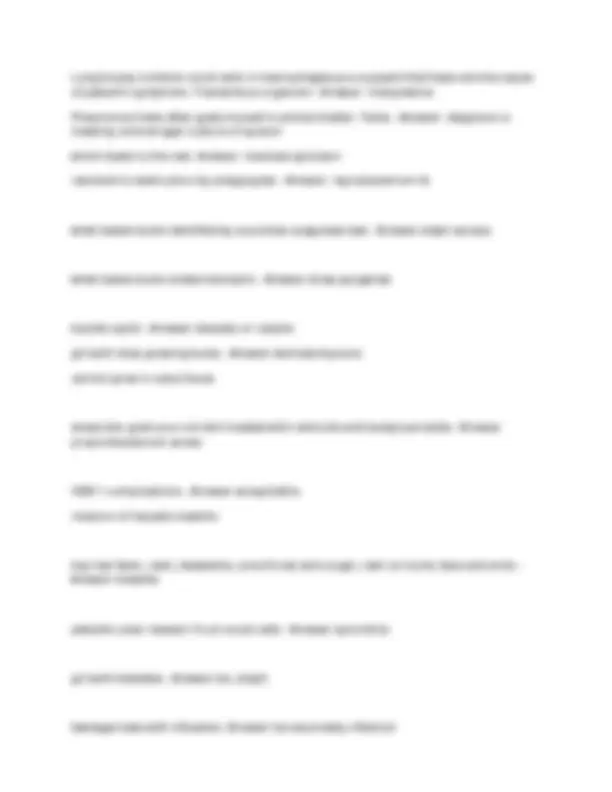
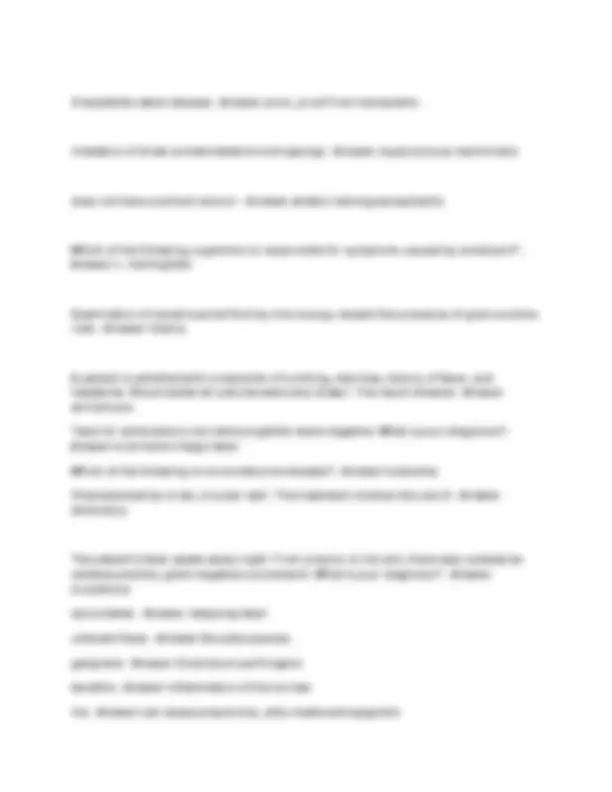
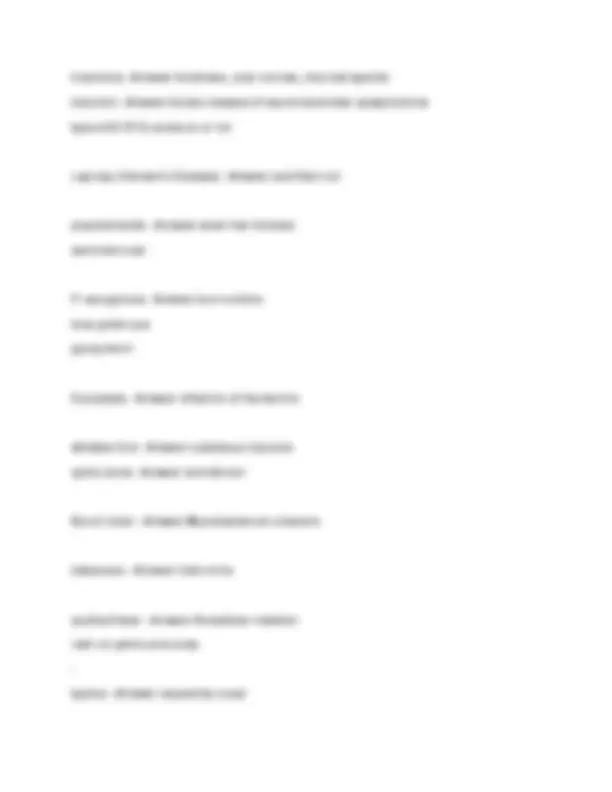
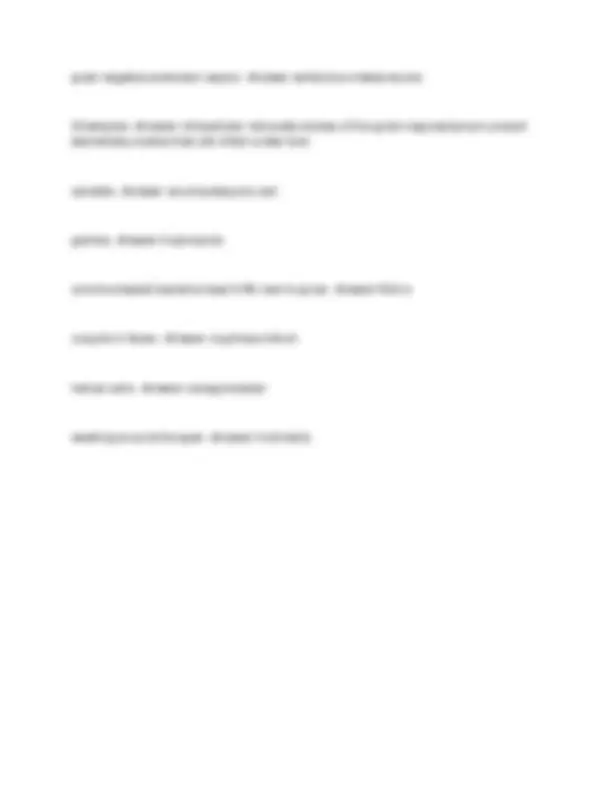


Study with the several resources on Docsity

Earn points by helping other students or get them with a premium plan


Prepare for your exams
Study with the several resources on Docsity

Earn points to download
Earn points by helping other students or get them with a premium plan
Community
Ask the community for help and clear up your study doubts
Discover the best universities in your country according to Docsity users
Free resources
Download our free guides on studying techniques, anxiety management strategies, and thesis advice from Docsity tutors
MCPHS Microbiology Self Paced Exam Questions And Answers
Typology: Exams
1 / 27

This page cannot be seen from the preview
Don't miss anything!




















Pathogenicity - The ability to cause disease Virulence - the extent of pathogenicity Portals of entry - Mucous membranes, skin, parenteral route ID50 (infectious dose) - The number of microbes that must enter the body to establishinfection in 50% of test animals is expressed as the ID
LD50 - lethal dose of a toxin for 50% of the test population Adherence-Answer Adhesins / ligands bind to host cell receptors, form biofilms Glycocalyx: streptococcus mutansFimbriae: E.coli M proteins: Strepoccus pyogenes Pili, flagella, glycoproteins, lipoproteins Capsules- avoid phagocytosis- Answer Strep. Pneumoniae, Hib, bacillus anthraciscell wall components-Answer M proteins: mediates attachment and resists phagocytosis(strep. pyogenes) Opa protein: assist attachment and recept mediated endocytosis, inhibs helper t cells(n. gonorrhoeae) Mycolic acid: Waxy, resists digestion (mycobacterium TB)
Exoenzymes - Answer Coagulase: coagulates fibrinogen Kinases: digest fibrin clotshyaluronidase: hydrolyzes hyaluronic acid Collagenase: hydrolyzes collagenIgA proteases: destroys IgA antibodies
antigenic variation - Answer Change of surface antigens to avoid detection by hostantibodies Examples: flu, gonorrhea, trypanosoma brucei gambiense Invasins: Penetration into the host cell cytoskeleton - Answer Salmonella alters hostactin to enter a host cell Listeria uses actin to move from one cell to the next Direct damage caused by - Answer disrupts the host cells function produces waste productstoxins induces hypersensitive reactions damages immediate vicinityuse hosts nutrients (iron) -siderophores
Siderophores - Answer proteins that free host stores of iron Toxin - Answer substance that contributes to pathogenicity Toxoid - Answer inactivated toxin used in a vaccine
membrane disrupting exotoxins - Answer lyse host cells by disrupting plasmamembranes/disrupt phospholipid bilayer
Leukocidins: kill phagocytic leukocytes Hemolysins: destroy RBCs-Streptolysins
example: strep. pyogenes Superantigens - Answer cause an intense immune response due to release of cytokinesfrom host cells
Symptoms: fever, nausea, vomiting, diarrhea, shock, death Example: Staph. aureus Combine with macrophages Stimulate T cells LAL Assay - limulus amebocyte lysate assay - Answer detects endotoxins (horseshoecrabs white blood cells) will produce a clot
Commensalism - Answer one organism benefits and the other is unaffected Etiology - Answer study of the cause of disease Pathogenesis - Answer development of disease
infection - Answer colonization of the body by pathogens disease - Answer An abnormal state in which the body is not functioning normally transient microbiota -Answer could be there for weeks, months, or months.Symbiosis- Answer the relationship between the normal microbiota and host. -produce bacteriocins -produce acids-occupy niches which pathogens might occupy.
Microbial antagonism - Answer competition between microbes.Koch's Postulates-Answer
Herd Immunity Extent of host infection - Answer Local -limited to small areasystemic: throughout body focal: begins as a site-specific infectionprimary infection: Acute infection associated with an initial disease secondary: Opportunistic infection following the primary infection subclinical: no apparent s/s (inapparent infection)
Sepsis - Response Toxic inflammatory condition secondary to the distribution ofmicrobes, esp. bacteria or their toxins from a source of infection
predisposing factors leading to susceptibility to disease - Answer Gender, genetics,climate, weather, vaccines, age, behavior, religion, nutrition, environment, habits, lifestyle, fatigue, occupation, illness, chemotherapy, antigenic variants/drift Development of disease - Answer 1. Incubation period: interval between initial infectionand first signs and symptoms
resvior - Answer Humans, animals, nonlivingcarriers: inapparent infections, latent
transmission - Answer contact-indirect: fomile: nonliving object
droplets Vehiclefood, water, air, blood
Vector mechanical: passive carries pathogen on feet biological: pathogen reproduces in vector Common nosocomial infections - Answer Staph 15%, s. aureus 15%, enterococcus 10%,gram neg rods 15-25%, c. diff 13%
Microbes present in hosptials compromised hostchain of transmission breaks in first line of defense underlying disease Emerging new infections caused by - Answer Genetic recombinationevolution of new strains inappropritate use of antibiotics and pesticides changes in weathermodern transport Disasters, wars, human settlements Animal controlpublic health failures
Analytical: compares diseased group and healthy group Florence nightinggale case control methodcohort method
experiemental: ignaz semmelweis hypothesis, clincal trials MMWR - Answer Morbidity: incidence of specific notifiable disease Mortality: death from notificable disease morbitiy rate: number of people affected in relation to total popuation in given timeperiod mortality rate: number of deaths from a disease in relation to population at given time How can a local infection become a systemic infection? - Answer A systemic infectioncan occur when microorganisms that have caused a local infection enter a blood or lymph vessel and are carried throughout the body. Why do some organisms that constiture the normal microbiota described ascommensals whereas others are described as mutualistic - Answer Mutualistic microorganisms are providing a chemical or environment that is essential for the host.Commensal organisms are not essential; another microorganism might serve the function as well. This microbe is acquired by humans as infants and is essential for good health. - Answere coli
The rise of new infectious disease is probably due to all but - Answer The need ofbacteria to cause disease
Which of the following is not one of kochs postulates - Answer the disease must be
transmitted from a diseased animal to a healthy susceptible animal by direct contact Not correct reservoir - Answer anthrax-nonliving Maryland women hospitalized with dehydration - Answer vehcile transmissionvibrio cholerae crabs Which of the following is not a notifiable disease - Answer pneumonia Women who have a healthly population of lactoballius are less likely to have yeastinfections - Answer competitive exclusion
Not an example of microbial antagonism - Answer microbes producing vitaminsmutualism would produce vitamins
P. aeruginosa and all other gram-negative bacteria are not easily controllable byantibiotics, because they bear __________, which carry genes that determine resistance to antibiotics. - Answer R factors Germ-free (gnotobiotic) animals are frequently more susceptible to infections andserious disease than are animals with a typical complement of normal microbiota. Based upon this observation, which of the following would you consider an appropriateconclusion? - Answer normal microbiota stim. development of immune system
Which of the following is a plan formulated by the CDC, NIH, and WHO to identify andrank issues related to EIDs? - Answer All are part
Which of the following stages in the course of a disease would most likely be shortenedin duration if the inoculum at the initiation of infection is very large? - Answer Incubation period
only needs a little speciifity - Answer probabilty test not not be reactive if true negative Mantoux test - Answer cell mediated immunity Antimicrobial drugs - Answer interfere with the growth of microbes within a host Antibiosis - Production of an antibiotic by a microbe in small quantities to preventgrowth of other microbes in their vicinity
bacteriostatic- The prevention of microbes from growing Synergism- When the effect of two drugs together is greater than the effect of eitheralone
Antagonism- When the effect of two drugs together is less than the effect of either alone pcn and tetra Alexander Fleming - Answer PCN Howard Florey and Ernst Chain - Answer performed first clinical trials of penicillin Modes of action behind antibacterial drugs - Answer 1. inhibit cell wall synthesis -lysis pcn cephlo, bacitracin, vancom2. inhib protein synthesis bacteria have 70s ribosomes
chloram, erth, tetra, streto
Capsules play a role in the virulence of all of the following EXCEPT __________. - Answermycobacacterium tb
Which of the following toxins is NOT produced by a bacterium as a result of lysogenicconversion? - Answer endotoxin
Which would NOT be a factor that would affect the ability of Streptococcus mutans toadhere to teeth? - Answer The absence of Actinomyces, a bacterium that can form dental plaque Which of the following statements is NOT true of A-B exotoxins? - Answer They areproduced only by gram-negative bacteria.
Of the following, which virulence factor is specific to helping an organism physicallyspread through the body? - hyaluronidase
You run a LAL on a sample of fluid that should be sterile. You get a positive result. Whatdoes this mean? - endotoxin is present
A direct agglutination test could be used for which of the following? - Answer To detectantibodies against a bacterium
I developed a test for a pathogen that is very specific but NOT very sensitive. What doesthis mean? - Answer My test is very accurate, but there must be a lot of pathogen present for it to work. The viral hemagglutination inhibition test __________. - Answer can be used to detect thepresence of antibody to the measles virus in patient serum
Monoclonal antibodies do NOT have which of the following properties? - Answer Theyconsist of antibodies that react with many different antigens.
For both the direct and the indirect ELISA, __________. - Answer substrate is final step Which of the following immunological methods for serum antibody is an indicatordependent on cells? Answer complement fixator
Hemagglutination in an immunoassay __________. Answer involves antibodiescross-linking erythrocytes
In attempting to determine the strain of influenza in a patient by an indirect ELISA test,you would combine the following reagents. Which do you add FIRST? Answer antigen
Knowing that rubella virus causes hemagglutination, you mix red blood cells, rubellavirus, and a patient's serum in a tube. Hemagglutination does NOT occur. What do you conclude? - Answer The patient has antibodies against rubella virus. In a complement-fixation test, for a serum sample containing antibody against the targetantigen, __________. - Answer complement will be fixed, and sheep red blood cells will not lyse
To detect the presence of antibody to a pathogen in a person through use of the indirectfluorescent-antibody technique, __________. - Answer a known antigen is fixed to a slide, patient serum is added, and labeled antibodies that are directed against humanantibodies are added
The toxin neutralization assay __________. - Answer can detect the presence of antitoxin Which of the following statements is NOT true for the indirect ELISA? Answer antibodysandwich formed
The fluorescent-antibody test, in which labeled antibodies are added to a specimen on amicroscope slide, is called the __________ FA test. Answer direct
A drug that binds with sterols would injure __________. Answer eukaryotic membrane It is easier to use chemotherapy to treat bacterial infections compared to other types ofinfections caused by other forms of microorganisms. Why? - Answer bacteria are prokaryotic It is easier to use chemotherapy to treat bacterial infections compared to other types ofinfections caused by other forms of microorganisms. Why? - Answer ivermectin
Which of the following antimicrobial works via inhibiting mycolic acid synthesis? -Answer isoniazid
Which of the following does NOT explain the selective toxicity of sulfa drugs? - AnswerSulfa drugs increase the production of antimetabolites.
Chloroquine-resistant malaria is treated with __________. - Answer mefloquine Rifampin inhibits RNA polymerase and therefore blocks __________. - Answer
patients serum, chlamydia guinea pig complement sheep red blood cells and anti sheeprbc if pt has antibodies - Answer no hemolysis 49 year old man with a parakeet - Answer psittacosis You have a 200-milligram-per-milliliter antibiotic solution. You make serial dilutions 1:2,1:4, etc. of the antibiotic. You then inoculate each tube with Salmonella. Bacteria grow in tubes 4, 5 and 6. You subculture bacteria from tubes 1 through 3 to nutrient broth.Growth occurs in tubes 2 through 3. What is the MBC? -Answer 100 mg per ml
You have a 200 milligram-per-milliliter antibiotic solution. You make serial dilutions (1:2,1:4, etc.) of the antibiotic. You then inoculate each tube with Salmonella. Bacteria grow in tubes 4, 5, and 6. What is the MBC (minimum bactericidal concentration)? - Answernot enough to determine
What is the method of action of nucleoside analogs? - Answer inhibit dna synthesis All of the following are antiprotozoan drugs EXCEPT __________. - Answer mebendazole You have an antibiotic solution at 200 mg/ml. You do serial dilutions (1:2, 1:4, etc.) of theantibiotic; the first tube has 100 mg/ml. You add Salmonella to each tube. You find out that only tubes 4, 5, and 6 showed growth of bacteria. You do subculture of bacteriafrom tubes 1-3 in nutrient broth. Growth took place in the subculture tube 3. You can calculate that the MIC is __________. - Answer 25 mg per ml Which of the following does NOT describe a means by which antibiotic resistance isspread horizontally among bacteria? answer bacterial transcription
Which of the following antifungal drug was recently introduced to treat systemic fungalinfections? answer posaconazole
Polyenes, azoles, and allylamines interfere with __________. answer fungal cellmembranes
A NUCLEOSIDE ANALOG USED TO TREAT INFECTION BY HIV is ____. answerzidovuidine
Many antifungal drugs target __________ within the fungal cell membrane. answer sterols Tetracyclines are effective against all of the following EXCEPT __________. - Answerfungi
The drug Flagyl is commonly used to treat an STD caused by __________. - Answer trich-flagellated eukaryotes
antibiotic resistance - Answer 1. blocking entry : porins
precipitation reaction - Answer reaction of soluable antigens with igg or igm antibodies monocolonal antibodies - Answer chimeric -human/mouse umab humanomab mouse ximab chimera zumab humanizedmurine mouse